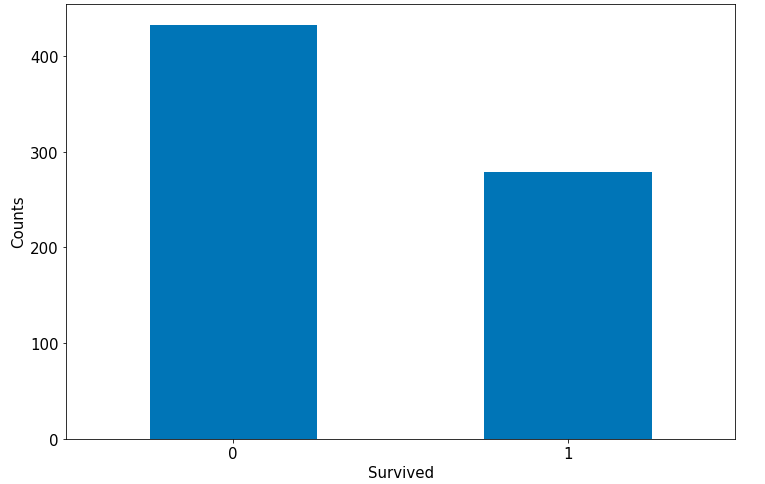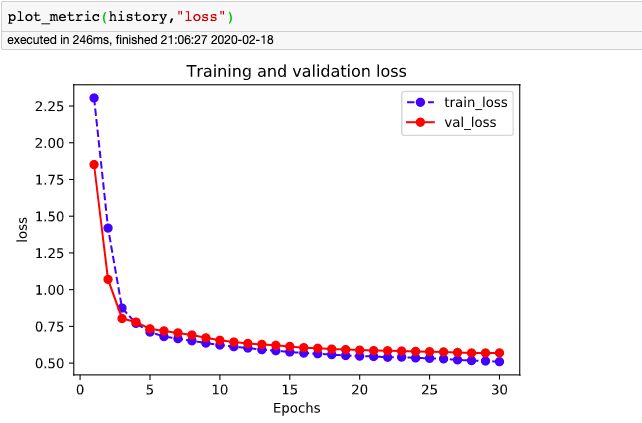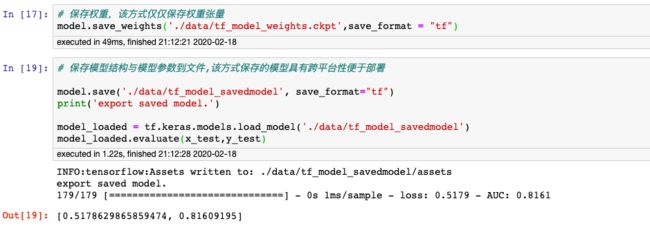TF2.0-结构化数据建模流程范例
尽管TensorFlow设计上足够灵活,可以用于进行各种复杂的数值计算。但通常人们使用TensorFlow来实现机器学习模型,尤其常用于实现神经网络模型。
从原理上说可以使用张量构建计算图来定义神经网络,并通过自动微分机制训练模型。但为简洁起见,一般推荐使用TensorFlow的高层次keras接口来实现神经网络网模型。
使用TensorFlow实现神经网络模型的一般流程包括:
1,准备数据
2,定义模型
3,训练模型
4,评估模型
5,使用模型
6,保存模型。
对新手来说,其中最困难的部分实际上是准备数据过程。
我们在实践中通常会遇到的数据类型包括结构化数据,图片数据,文本数据。
我们将分别以titanic生存预测问题,cifar2图片分类问题,imdb电影评论分类问题为例,演示应用tensorflow对这三类数据的建模方法。
本篇以titanic生存预测问题为例,演示应用tensorflow对结构化数据进行建模的方法。
一,准备数据
titanic数据集的目标是根据乘客信息预测他们在Titanic号撞击冰山沉没后能否生存。
结构化数据一般会使用Pandas中的DataFrame进行预处理。
import numpy as np
import pandas as pd
import matplotlib.pyplot as plt
import tensorflow as tf
from tensorflow.keras import models,layers
dftrain_raw = pd.read_csv('./data/titanic/train.csv')
dftest_raw = pd.read_csv('./data/titanic/test.csv')
dftrain_raw.head(10)
字段说明:
Survived:0代表死亡,1代表存活【y标签】
Pclass:乘客所持票类,有三种值(1,2,3) 【转换成onehot编码】
Name:乘客姓名 【舍去】
Sex:乘客性别 【转换成bool特征】
Age:乘客年龄(有缺失) 【数值特征,添加“年龄是否缺失”作为辅助特征】
SibSp:乘客兄弟姐妹/配偶的个数(整数值) 【数值特征】
Parch:乘客父母/孩子的个数(整数值)【数值特征】
Ticket:票号(字符串)【舍去】
Fare:乘客所持票的价格(浮点数,0-500不等) 【数值特征】
Cabin:乘客所在船舱(有缺失) 【添加“所在船舱是否缺失”作为辅助特征】
Embarked:乘客登船港口:S、C、Q(有缺失)【转换成onehot编码,四维度 S,C,Q,nan】
利用Pandas的数据可视化功能我们可以简单地进行探索性数据分析EDA(Exploratory Data Analysis)。
label分布情况
%matplotlib inline
%config InlineBackend.figure_format = 'png'
ax = dftrain_raw['Survived'].value_counts().plot(kind = 'bar',
figsize = (12,8),fontsize=15,rot = 0)
ax.set_ylabel('Counts',fontsize = 15)
ax.set_xlabel('Survived',fontsize = 15)
plt.show()
年龄分布情况
%matplotlib inline
%config InlineBackend.figure_format = 'png'
ax = dftrain_raw['Age'].plot(kind = 'hist',bins = 20,color= 'purple',
figsize = (12,8),fontsize=15)
ax.set_ylabel('Frequency',fontsize = 15)
ax.set_xlabel('Age',fontsize = 15)
plt.show()
年龄和label的相关性
%matplotlib inline
%config InlineBackend.figure_format = 'png'
ax = dftrain_raw.query('Survived == 0')['Age'].plot(kind = 'density',
figsize = (12,8),fontsize=15)
dftrain_raw.query('Survived == 1')['Age'].plot(kind = 'density',
figsize = (12,8),fontsize=15)
ax.legend(['Survived==0','Survived==1'],fontsize = 12)
ax.set_ylabel('Density',fontsize = 15)
ax.set_xlabel('Age',fontsize = 15)
plt.show()
下面为正式的数据预处理
def preprocessing(dfdata):
dfresult= pd.DataFrame()
#Pclass
dfPclass = pd.get_dummies(dfdata['Pclass'])
dfPclass.columns = ['Pclass_' +str(x) for x in dfPclass.columns ]
dfresult = pd.concat([dfresult,dfPclass],axis = 1)
#Sex
dfSex = pd.get_dummies(dfdata['Sex'])
dfresult = pd.concat([dfresult,dfSex],axis = 1)
#Age
dfresult['Age'] = dfdata['Age'].fillna(0)
dfresult['Age_null'] = pd.isna(dfdata['Age']).astype('int32')
#SibSp,Parch,Fare
dfresult['SibSp'] = dfdata['SibSp']
dfresult['Parch'] = dfdata['Parch']
dfresult['Fare'] = dfdata['Fare']
#Carbin
dfresult['Cabin_null'] = pd.isna(dfdata['Cabin']).astype('int32')
#Embarked
dfEmbarked = pd.get_dummies(dfdata['Embarked'],dummy_na=True)
dfEmbarked.columns = ['Embarked_' + str(x) for x in dfEmbarked.columns]
dfresult = pd.concat([dfresult,dfEmbarked],axis = 1)
return(dfresult)
x_train = preprocessing(dftrain_raw)
y_train = dftrain_raw['Survived'].values
x_test = preprocessing(dftest_raw)
y_test = dftest_raw['Survived'].values
print("x_train.shape =", x_train.shape )
print("x_test.shape =", x_test.shape )
二,定义模型
使用Keras接口有以下3种方式构建模型:使用Sequential按层顺序构建模型,使用函数式API构建任意结构模型,继承Model基类构建自定义模型。
此处选择使用最简单的Sequential,按层顺序模型。
tf.keras.backend.clear_session()
model = models.Sequential()
model.add(layers.Dense(20,activation = 'relu',input_shape=(15,)))
model.add(layers.Dense(10,activation = 'relu' ))
model.add(layers.Dense(1,activation = 'sigmoid' ))
model.summary()
三,训练模型
训练模型通常有3种方法,内置fit方法,内置train_on_batch方法,以及自定义训练循环。此处我们选择最常用也最简单的内置fit方法。
# 二分类问题选择二元交叉熵损失函数
model.compile(optimizer='adam',
loss='binary_crossentropy',
metrics=['AUC'])
history = model.fit(x_train,y_train,
batch_size= 64,
epochs= 30,
validation_split=0.2 #分割一部分训练数据用于验证
)
四,评估模型
我们首先评估一下模型在训练集和验证集上的效果。
%matplotlib inline
%config InlineBackend.figure_format = 'svg'
import matplotlib.pyplot as plt
def plot_metric(history, metric):
train_metrics = history.history[metric]
val_metrics = history.history['val_'+metric]
epochs = range(1, len(train_metrics) + 1)
plt.plot(epochs, train_metrics, 'bo--')
plt.plot(epochs, val_metrics, 'ro-')
plt.title('Training and validation '+ metric)
plt.xlabel("Epochs")
plt.ylabel(metric)
plt.legend(["train_"+metric, 'val_'+metric])
plt.show()
我们再看一下模型在测试集上的效果.
五,使用模型
六,保存模型
可以使用Keras方式保存模型,也可以使用TensorFlow原生方式保存。前者仅仅适合使用Python环境恢复模型,后者则可以跨平台进行模型部署。
推荐使用后一种方式进行保存。
1,Keras方式保存
2,TensorFlow原生方式保存













